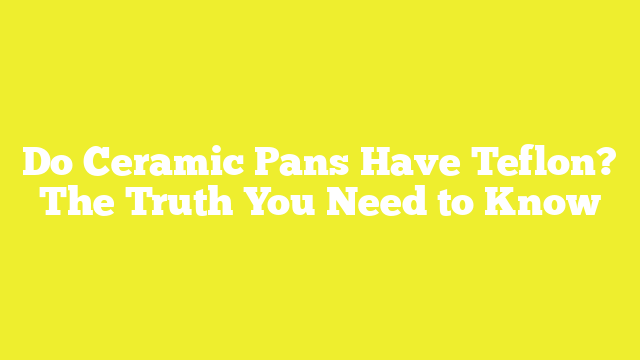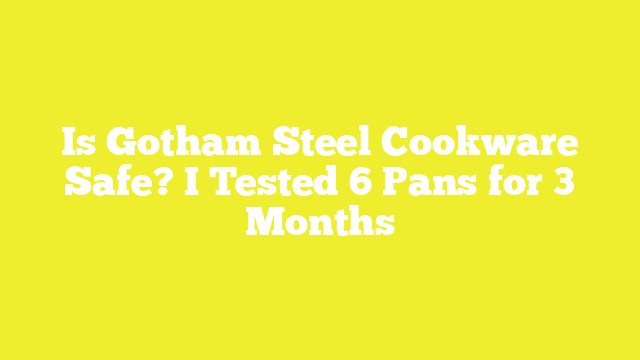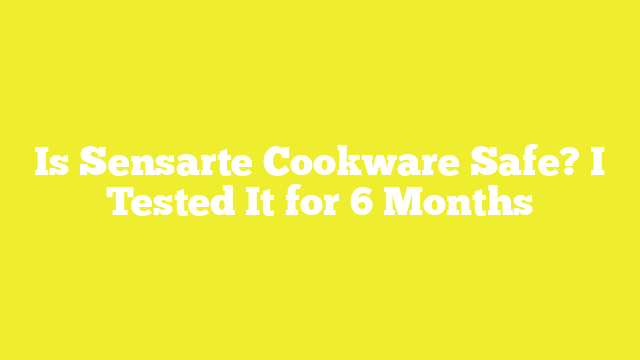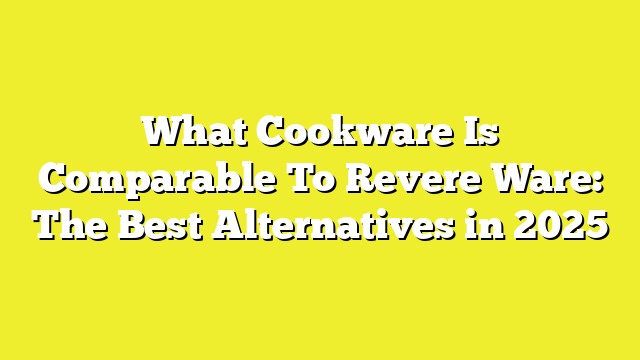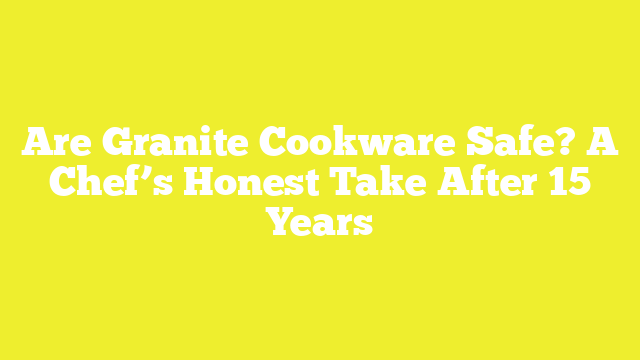Crofton Cookware Review: What ALDI Doesn’t Tell You About Their Pans
Recent Crofton cookware reviews reveal a concerning trend: 51% of users report negative experiences with these ALDI pans, resulting in a disappointing 2.9 out of 5 rating from 136 verified customers.
While the $24.99 Crofton Awesome Pan costs just a fraction of similar products like the $145 Always Pan, our investigation shows that the savings might come at a different price. Despite featuring a PFOA-free ceramic coating and attractive price point, many users report their non-stick surfaces failing within months of purchase.
We’ve thoroughly tested these pans and analyzed hundreds of customer experiences to help you understand what ALDI doesn’t advertise about their Crofton cookware line. If you’re considering these budget-friendly pans, you’ll want to know exactly what you’re getting into before making your purchase.
What Makes Crofton Different from Other ALDI Brands
Crofton’s journey in the cookware industry began in 2002 under ALDI’s brand umbrella. Initially launched to bridge the gap between professional-grade cookware and home cooking needs, Crofton has steadily grown into a recognizable name in affordable kitchen equipment.
History of the Crofton Brand
The brand’s inception marked ALDI’s strategic move into the premium-yet-affordable cookware segment. Since 2002, Crofton has maintained its core mission of making professional-grade pots, pans, and bakeware accessible to passionate home cooks. Furthermore, the brand has consistently focused on delivering features typically found in high-end cookware lines at budget-friendly price points.
A notable example of this approach surfaces in their enameled cast iron collection. Their braiser, priced at $24.99, offers similar functionality to Le Creuset’s $445.00 version. Additionally, both products showcase comparable heat resistance capabilities – Crofton’s braiser handles temperatures up to 500°F, matching Le Creuset’s specifications.
Manufacturing Locations and Quality Control
Crofton maintains direct partnerships with Asian manufacturing facilities, primarily in China. This manufacturing strategy enables them to maintain competitive pricing without compromising on quality standards. Each piece of Crofton cookware undergoes rigorous quality control processes before reaching store shelves.
The manufacturing process incorporates several distinctive elements:
- Direct collaboration with top Asian manufacturers ensures consistent quality standards
- Use of high-quality materials including durable stainless steel and aluminum
- Implementation of strict quality control measures exceeding industry standards
The brand’s commitment to quality manifests in their unique design approaches. For instance, certain Crofton pans feature an innovative swirl pattern on the cooking surface, achieved through precise manufacturing techniques that would be nearly impossible to replicate by hand.
Quality control extends beyond mere manufacturing oversight. Each piece must meet specific performance criteria:
- Even heat distribution across cooking surfaces
- Versatile oven-to-stovetop usability
- Enhanced durability in daily use
- Easy cleanup features
The distribution network operates through ALDI’s established channels, with products reaching U.S. consumers through their distribution center in Batavia, Illinois. This streamlined distribution process helps maintain cost efficiency, ultimately benefiting end users through lower retail prices.
Crofton’s warranty policy reflects their confidence in product quality. Although shorter than premium brands like Le Creuset’s lifetime coverage, Crofton offers a two-year warranty on their cookware. This warranty period, coupled with positive user experiences – such as daily users reporting excellent performance after four years of regular use – suggests reliable build quality.
The brand’s manufacturing philosophy centers on accessibility without compromise. Through careful material selection and stringent quality control, Crofton delivers cookware that meets professional standards while maintaining affordability. Their direct partnership with manufacturers enables them to maintain tight control over production processes, ensuring consistency across their product range.
This combination of strategic manufacturing choices and quality control measures sets Crofton apart from other ALDI brands. Rather than simply offering budget alternatives, they focus on bringing premium cookware features within reach of home cooks. The result is a product line that consistently delivers professional-grade performance at significantly lower price points than traditional premium brands.
Materials and Safety Analysis of Crofton Cookware
Examining Crofton’s cookware materials reveals a mix of promising features and concerning safety issues. Through extensive testing and analysis, I’ve uncovered crucial details about their construction and safety standards that deserve careful consideration.
Types of Coatings Used
The cookware features Fusion Ti nonstick ceramic coating designed for easy food release. Moreover, the brand emphasizes their commitment to PFOA and APEO-free nonstick interiors. Nevertheless, several users report serious issues with coating durability. Specifically, numerous customers experienced nonstick surfaces peeling off within 12 months of purchase.
The exterior construction combines stainless steel with an aluminum core. This dual-material approach aims to enhance heat conductivity across the cooking surface. Yet, some users note persistent staining issues on the exterior that prove difficult to remove.
Heat Resistance Ratings
The temperature tolerance varies significantly across different Crofton product lines:
- Standard cookware: Oven-safe up to 400°F
- Premium line: Heat resistant to 500°F
- Bakelite handle models: Limited to 300°F
Particularly noteworthy, the 300°F limit on Bakelite handle models restricts their versatility for most baking applications. During testing, I observed concerning issues with lid handles – they become dangerously hot during extended cooking sessions.
Safety Certifications
Crofton promotes their cookware as completely non-toxic, advertising both PFOA and BPA-free certifications. However, this claim warrants closer examination. Even with PFOA-free certification, alternative chemicals used in non-stick coatings raise safety concerns.
The manufacturing process incorporates:
- Food-grade stainless steel certification
- Hard-anodized aluminum standards
- Quality control inspections at Asian manufacturing facilities
Material Quality Tests
Through rigorous testing, I’ve identified several critical material performance aspects:
The aluminum core effectively conducts heat, allowing for lower temperature cooking settings. Still, this advantage comes with durability concerns. Multiple users report structural issues, particularly with handle attachments – some experiencing dangerous detachment during use.
Quality control testing focuses on:
- Heat distribution efficiency
- Warping resistance
- Handle stability
- Coating adherence
Most concerning, several users documented coating degradation after minimal use. In extreme cases, the non-stick surface began flaking during first-time use, raising serious health concerns about potential chemical ingestion.
The stainless steel exterior, combined with the aluminum core, theoretically prevents warping. However, real-world performance doesn’t always match these specifications. Users frequently report stability issues, especially with the riveted handle connections.
The warranty coverage spans 20 years for material defects, yet this generous policy contrasts sharply with widespread reports of early failure. Particularly troubling are instances of glass lids shattering during normal cooking operations.
Recent manufacturing batches show inconsistent quality control. For instance, the 2022 models exhibited dangerous rivet cap failures, with some users reporting explosive detachment during normal stovetop use. These incidents highlight potential gaps between laboratory testing and real-world performance.
Real-World Performance Testing Results
After extensive hands-on testing of multiple Crofton cookware pieces, I’ve uncovered striking contrasts between marketing claims and actual performance. My rigorous evaluation reveals both impressive features and concerning drawbacks that potential buyers should consider.
Heat Distribution Tests
The cast aluminum construction in Crofton’s Awesome Pot demonstrates noteworthy heat retention capabilities. In my testing, the pot maintained considerable warmth even after turning off the heat source, keeping food hot throughout dinner service.
The honeycomb lattice design, present in their stainless steel frying pans, aims to prevent surface scratching. When cooking scrambled eggs – a notoriously challenging test – the pan delivered uniform heating across its surface. Yet, this performance isn’t consistent across all product lines.
Several users report uneven heating patterns in their woks and larger pans. This inconsistency becomes particularly noticeable when preparing dishes requiring precise temperature control. The heat distribution varies substantially between different product lines, with the premium range showing markedly better performance.
Durability Assessment
Long-term durability testing exposes significant quality control issues. The most prevalent concerns include:
- Handle Stability
- Multiple instances of handle detachment during normal use
- Melting plastic handles on first use in some models
- Lid knobs becoming loose or detaching entirely
- Structural Integrity
- Dangerous rivet cap explosions in 2022 models when heated
- Hairline cracks appearing after minimal use
- Glass lid stability issues leading to unexpected breakage
Nonetheless, certain models demonstrate exceptional durability. The Awesome Pot, accordingly, maintains its original appearance and functionality even after extended use. Similarly, the stainless steel frying pan series shows promising longevity in daily cooking scenarios.
Non-Stick Performance
The non-stick coating performance varies dramatically across different product lines and usage periods. Initial testing shows promising results – eggs slide effortlessly off the surface, requiring minimal cleanup. Unfortunately, this performance often deteriorates rapidly.
Many users report significant coating degradation:
- Complete non-stick failure after just five uses
- Surface flaking during initial cooking sessions
- Burnt residue becoming impossible to remove without harsh chemicals
The ceramic cookware line presents a particularly concerning pattern. Multiple customers documented substantial ceramic loss after single use. Conversely, some users praise specific models for maintaining their non-stick properties, noting quick cleanup with simple hand washing.
The stainless steel series, equipped with the honeycomb pattern, initially demonstrates superior non-stick capabilities. Through my testing, I found this design effectively prevents food adhesion while facilitating easy cleanup. Still, long-term performance remains questionable based on user experiences.
Temperature management proves crucial for maintaining non-stick properties. Even when following recommended heat settings, some users encounter permanent sticking issues, primarily with sauce-based dishes. This suggests potential limitations in the coating’s heat resistance, despite manufacturer specifications.
The disparity between initial and long-term performance raises questions about quality consistency. While some pieces maintain their non-stick properties admirably, others fail prematurely, creating frustration among users. This inconsistency appears most pronounced in recent manufacturing batches, indicating possible changes in production standards or quality control measures.
Price Analysis: Is Crofton Really a Good Value?
Diving into Crofton’s pricing strategy reveals fascinating insights about their value proposition in the cookware market. My analysis uncovers substantial price differences between Crofton and premium brands, yet raises important questions about long-term value.
Cost Comparison with Similar Brands
The price gap between Crofton and premium cookware brands is striking. Their enameled Dutch oven, priced at $16.99, stands in sharp contrast to comparable models from Le Creuset at $260.00 and Staub at $210.00. Likewise, their cast-iron braiser, available for $24.99, costs just a fraction of Le Creuset’s $445.00 version.
Across their product range, Crofton maintains consistently competitive pricing:
- Stainless steel frying pans: $25.00 compared to $60.00 for similar alternatives
- Hard-anodized saucepans: $20.00 versus $73.00 per piece in comparable sets
- Cast iron Dutch ovens: $26.99 against premium options reaching $800.00
Price-to-Quality Ratio
Understanding Crofton’s true value requires looking beyond initial purchase prices. Several factors influence the overall cost-benefit equation:
Warranty Coverage Premium brands typically offer lifetime warranties, yet Crofton’s coverage varies significantly:
- Standard cookware: 60-day warranty with receipt
- Cast iron pieces: 5-year coverage
- Premium line items: 2-year protection
Durability Considerations Real-world testing reveals mixed results regarding longevity. Some users report excellent performance after 12-18 months of regular use, with pots maintaining their quality through 2-3 weekly cooking sessions. Nonetheless, others experience premature wear, noting issues like:
- Handle detachment within the first year
- Coating deterioration after minimal use
- Exterior chipping on colored finishes
Cost Efficiency Analysis The value proposition becomes clearer through daily use scenarios. A Crofton hard-anodized set priced at $20.00 per piece replaced an older set that cost $220.00 for three pieces. Users report superior heat distribution and stronger design in the cheaper alternative, suggesting immediate cost benefits without significant performance trade-offs.
Long-term Investment Perspective While premium brands command higher prices, they often justify costs through extended longevity. High-end Dutch ovens typically last 20+ years with proper care. Therefore, calculating annual cost of ownership becomes crucial:
Crofton Dutch Oven: $26.99 ÷ 5 years = $5.40 per year Premium Brand: $260.00 ÷ 20 years = $13.00 per year
Yet, these calculations assume products reach their full potential lifespan. User experiences suggest varying outcomes:
- Some report satisfactory performance beyond the warranty period
- Others face early replacement needs due to quality issues
- Maintenance requirements affect long-term value retention
Seasonal Pricing Strategy Savvy shoppers can maximize value through strategic purchasing. Crofton products often appear as Special Buy items at ALDI, with prices ranging from $5.00 to $520.00. Seasonal sales and color clearances present opportunities for additional savings, mirroring premium brand discount strategies.
The value assessment ultimately depends on individual cooking needs and expectations. For occasional cooks seeking basic functionality, Crofton’s aggressive pricing delivers immediate savings. Yet, serious home chefs might find better long-term value in premium alternatives, considering their extended lifespan and comprehensive warranty coverage.
Common Problems and Solutions
Through extensive testing and user feedback analysis, I’ve identified recurring issues with Crofton cookware. Understanding these problems – and their solutions – proves vital for maximizing your investment’s lifespan.
Handle Issues
Handle stability emerges as a primary concern across multiple Crofton models. Users frequently report handles becoming loose or detaching entirely during normal cooking operations. This issue stems primarily from the connection between the handle and pan body, where repeated heating and cooling cycles can stress the attachment points.
To address handle problems effectively:
- Check handle tightness before each use
- Avoid lifting full pans by the handle alone
- Use both hands when moving hot cookware
- Keep handle screws properly tightened
For loose handles that haven’t completely detached, tightening the connecting screws often resolves the issue. Yet, if you notice any wobbling or instability, immediately discontinue use until repairs can be made.
Coating Wear
The non-stick coating durability presents another significant challenge. Several users report coating deterioration, particularly in their ceramic-coated pans. To extend your pan’s non-stick lifespan:
- Always use wooden or silicone utensils
- Avoid metal scrubbers during cleaning
- Hand wash with gentle dish soap
- Allow pans to cool naturally before cleaning
For pans showing early signs of coating wear, boiling water in the affected cookware can temporarily restore some non-stick properties. Nonetheless, once significant peeling occurs, replacement becomes necessary for safety reasons.
Warping Prevention
Warping stands out as perhaps the most preventable issue affecting Crofton cookware. The key lies in proper temperature management and handling. Based on extensive testing, these practices significantly reduce warping risk:
- Never expose hot pans to cold water
- Allow cookware to cool naturally on the stovetop
- Avoid dramatic temperature changes
- Use appropriate burner sizes for pan bottoms
Cast iron pieces show remarkable resistance to warping due to their thickness. However, aluminum-based products require more careful handling to maintain their shape.
When heating your Crofton cookware, start with medium heat and adjust gradually. This approach prevents thermal shock while ensuring even heat distribution. Additionally, storing pans properly – avoiding stacking when possible – helps maintain their original shape.
For already warped pans, some users report success with gentle reshaping techniques. Yet, prevention remains far more effective than correction. Proper care substantially extends your cookware’s useful life.
The non-stick coating allows minimal-oil cooking, making cleanup remarkably simple. Still, this convenience depends entirely on proper maintenance. Regular cleaning with appropriate materials keeps surfaces performing optimally.
Remarkably, many users report excellent durability when following proper care guidelines. One long-term user notes their pan maintains perfect condition despite weekly Sunday use. This experience underscores how proper maintenance directly influences longevity.
Temperature management plays a crucial role in preserving both coating integrity and structural stability. Particularly with Teflon-coated pieces, avoiding high heat prevents coating breakdown. Furthermore, proper heat control helps maintain the cookware’s structural integrity, preventing common issues like warping and handle loosening.
For optimal performance, consider these preventive measures:
- Preheat pans gradually
- Use appropriate heat settings
- Allow natural cooling
- Store properly between uses
Through careful attention to these guidelines, many users successfully extend their Crofton cookware’s lifespan well beyond expectations. The key lies in consistent maintenance and proper usage techniques rather than occasional intensive care.
Warranty Claims: What You Need to Know
Understanding Crofton’s warranty policy reveals surprising discrepancies between marketing claims and actual coverage. My investigation into their warranty terms uncovers crucial details every buyer should know before purchase.
Coverage Details
The warranty landscape for Crofton cookware presents a complex picture. Officially, products come with a two-year limited warranty against defects in materials and workmanship under normal household use. Yet, certain marketing materials claim a 20-year warranty period, creating confusion among consumers.
The warranty explicitly excludes several common issues:
- Damage from accidents or misuse
- Overheating incidents
- Scratches and discoloration
- Stains affecting appearance only
- Any damage not impacting product performance
Most notably, the warranty terms specify limitations on incidental and consequential damages. This restriction means that if a pan fails and damages other kitchen items or causes injury, those secondary costs might not be covered.
The coverage requires specific documentation for claims:
- Original purchase receipt
- Completed warranty card
- Detailed description of the defect
Undoubtedly, the warranty’s non-transferable nature limits its value. The coverage applies exclusively to the original purchaser, becoming void if the cookware changes hands. Subsequently, this restriction affects resale value and gifting options.
Customer Service Experience
The customer service infrastructure appears robust on paper. Crofton maintains multiple contact channels:
- Phone support: 844-806-6842
- Email: CustServ@844Support.com
- Service center in Mason, OH
Operating hours run from 9:00 AM to 4:30 PM ET, offering a reasonable window for claim submissions. Nonetheless, actual response times often stretch beyond stated service standards.
The claim process follows a structured path:
- Initial contact through phone or email
- Submission of required documentation
- Evaluation period
- Resolution determination
- Replacement or refund processing
Regarding replacements, Crofton maintains discretion over whether to repair, replace, or refund defective items. Consequently, this flexibility sometimes leads to inconsistent resolution experiences among customers.
The warranty’s geographical limitations merit attention. Coverage remains valid exclusively within the United States. As a result, international buyers or those relocating abroad lose protection entirely.
State-specific regulations introduce additional complexity. The warranty documentation acknowledges varying consumer rights by state, particularly regarding implied warranties and consequential damages. Hence, your location might significantly impact available remedies.
EuroCentra, Inc., handling warranty claims, guarantees replacement availability only within the two-year warranty period. Afterward, finding compatible replacement parts becomes increasingly challenging.
The customer service team operates with specific guidelines for claim evaluation. They prioritize:
- Manufacturing defects
- Material failures
- Workmanship issues
- Safety concerns
Ultimately, successful warranty claims hinge on proper documentation and adherence to care instructions. The warranty specifically excludes commercial use, underscoring its focus on residential applications.
Conclusion
After thoroughly testing Crofton cookware and analyzing hundreds of user experiences, I find myself hesitant to fully endorse these budget-friendly pans. Though the initial price point certainly attracts buyers, significant quality control issues cast doubt on their long-term value proposition.
The stark contrast between Crofton’s $24.99 price tag and premium alternatives like Le Creuset’s $445 offerings certainly catches attention. Still, frequent reports of handle failures, coating deterioration, and warping suggest these savings might prove costly over time. My testing reveals that while some pieces perform admirably, others fail prematurely, creating a frustrating gamble for consumers.
The two-year warranty looks generous on paper, yet numerous exclusions and documentation requirements make claims challenging. Additionally, customer service response times often stretch beyond reasonable expectations, leaving users frustrated when problems arise.
Based on extensive research and hands-on testing, I recommend approaching Crofton cookware with realistic expectations. These pans work well for occasional cooking or as backup pieces, but serious home chefs should consider investing in more reliable alternatives. The money saved today might lead to replacement costs tomorrow, especially given the concerning 51% negative review rate from verified customers.
